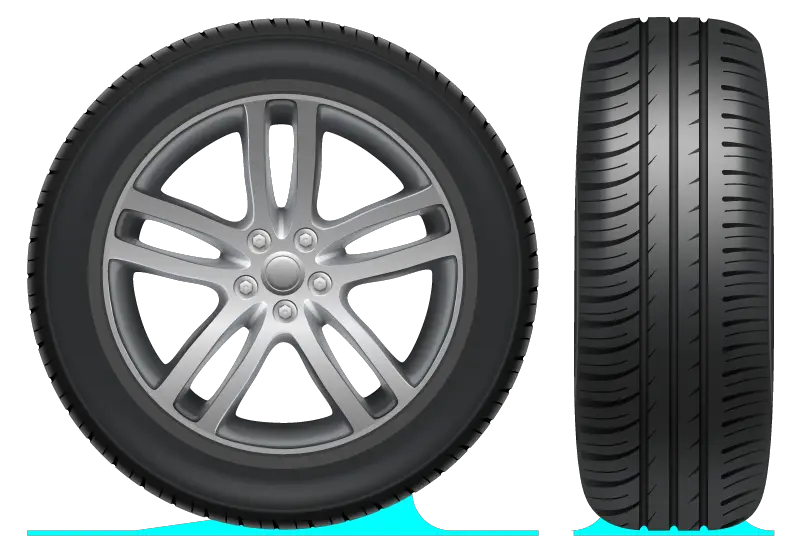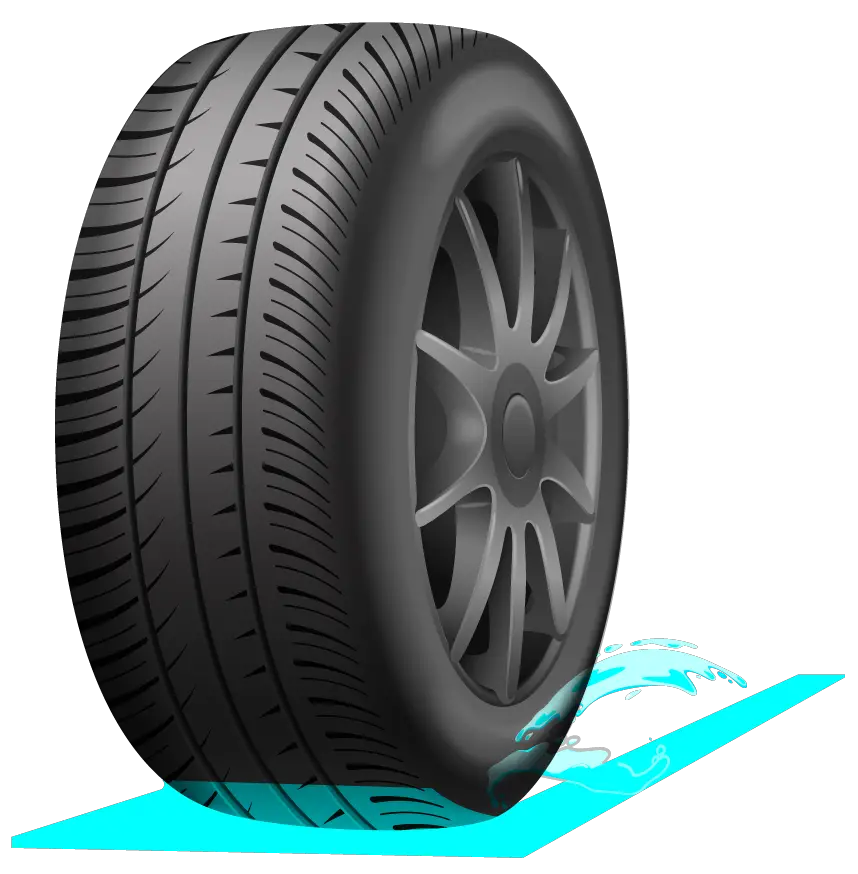When you’re behind the wheel, the connection between your car and the road is your tires – a crucial link that becomes even more vital in the rain. For many drivers, the question of whether wider tires enhance this connection in wet conditions is more than just technical curiosity; it’s about safety, control, and confidence.
Are Wider Tires Better In Rain?
Wider tires generally offer better grip and handling in dry conditions due to their larger contact patch, but in wet conditions, especially concerning hydroplaning, they may not always be the best choice.
Narrower tires can offer better performance in rain by effectively displacing water and reducing the risk of hydroplaning.
In this article, we explore the complex relationship between tire width, grip, and performance in rainy conditions, particularly focusing on the phenomenon of hydroplaning. We delve into the science behind tire design and offer practical advice for choosing the right tires for your vehicle, keeping both safety and performance in mind.
Understanding Tire Width
Before we get into the nitty-gritty, it’s essential to understand what we mean by tire width. Simply put, tire width is the measurement of how wide the tire is from one sidewall to another. This dimension is crucial because it determines the size of the tire’s contact patch with the road – the area that actually touches the ground as you drive.
- Larger Contact Patch: Wider tires have a larger contact patch, which in theory, should provide more grip.
- Improved Handling: This increased grip often translates to better handling, especially in dry conditions.
Insights from the BMW 320d Test
To give you a real-world perspective, let’s refer to a fascinating test conducted by Tyre Review using a BMW 320d. They experimented with different tire widths, specifically Goodyear Eagle F1 Asymmetric tires sized 225/40/R19, 255/35/R19, and 285/30/R19. This test sheds light on how tire width affects a car’s performance:
- Varied Performance: The test results showed varied performance in different conditions, proving that tire width impacts handling and grip differently depending on whether the road is wet or dry.
- Dry vs. Wet Conditions: In dry conditions, the wider tires (255 fronts and 285 rears) excelled, offering better handling and braking. However, in wet conditions, the story changed a bit.
The Impact on Wet Handling
When the road gets wet, the dynamics change. The test revealed that in wet conditions, wider tires didn’t always come out on top. For instance:
- Slower Lap Times: The wider tire setup was nearly 2.0 seconds slower on a wet handling lap compared to 255s on all four corners.
- Reduced Aquaplaning Resistance: In terms of aquaplaning, or hydroplaning resistance, wider tires (255) gave up some ground to narrower ones (225).

The Science Behind Hydroplaning
When we talk about driving in the rain, one term that often surfaces is hydroplaning – a moment that can make even the most experienced driver’s heart skip a beat. Understanding hydroplaning is key to appreciating how tire width impacts your driving experience in wet conditions. So, let’s break it down and explore the relationship between tire width and hydroplaning.
What is Hydroplaning?
Hydroplaning, also known as aquaplaning, occurs when a layer of water builds up between the tires of a vehicle and the road surface. This layer of water leads to a loss of traction, preventing the vehicle from responding to control inputs like steering, braking, or accelerating.
- Loss of Traction: Hydroplaning essentially means your tires are floating on water, losing contact with the road.
- Reduced Control: This can result in a loss of steering control, braking ability, and can cause the vehicle to slide uncontrollably.
How Does Tire Width Influence Hydroplaning?
Tire width plays a significant role in hydroplaning. Here’s how:
- Wider Tires: They have a larger contact patch, which can be both a blessing and a curse. While they offer more grip in dry conditions, this larger surface area can make them more susceptible to hydroplaning in wet conditions.
- Narrower Tires: These tires have a smaller contact patch and can cut through standing water more effectively, reducing the risk of hydroplaning.
Insights from Tyre Review’s BMW 320d Test
The BMW 320d test conducted by Tyre Review highlighted some key points regarding tire width and hydroplaning:
- Wider Tires Struggle in Wet Conditions: The test showed that wider tires (255 and 285) performed less effectively in resisting hydroplaning compared to the narrower 225 tires.
- Performance Variance: In wet conditions, the wider tires did not maintain the same level of grip and control as they did in dry conditions, leading to longer braking distances and less responsive handling.
Wider Tires in Dry vs. Wet Conditions
Navigating the debate between wider and narrower tires becomes especially intriguing when we consider their performance in different weather conditions. How do wider tires fare on dry versus wet roads? Let’s delve into this by drawing insights from real-world tests and understanding the physics at play.
Performance of Wider Tires on Dry Roads
In dry conditions, the story of wider tires is mostly a tale of triumph:
- Increased Grip: The larger contact patch of wider tires provides more grip on dry roads, leading to improved handling and stability.
- Better Braking: They also typically offer better braking performance, as seen in the BMW 320d test with Goodyear Eagle F1 Asymmetric tires.
But what happens when these roads get wet?
The Shift in Dynamics: Wet Roads
Here’s where the plot thickens. The same features that make wider tires a hit on dry roads can turn into a bit of a pitfall when the rain pours down:
- Reduced Efficiency in Water Displacement: Wider tires can struggle to displace water as effectively as narrower ones, increasing the likelihood of hydroplaning.
- Longer Braking Distances: In the BMW 320d test, wider tires demonstrated longer braking distances in wet conditions compared to their narrower counterparts.
A Note on Tire Tread and Design
While discussing tire width, it’s also vital to consider the tire’s tread design and overall build. These factors immensely contribute to how a tire performs under different weather conditions.
- Tread Design: A tire with an efficient tread design can improve water displacement, thereby reducing the risk of hydroplaning.
- Overall Build Quality: The build and material quality of the tire also play a crucial role in ensuring safety and performance.
The Trade-offs of Tire Width in Rain
When it comes to choosing the right tire width for rainy conditions, it’s not just about picking the widest option available. The interaction between tire width and rain is nuanced, involving a careful balancing act between various factors. Let’s explore these trade-offs to help you make a more informed decision for your wet-weather driving needs.
Understanding the Compromises
In the world of tires, especially when dealing with wet conditions, every advantage often comes with a corresponding trade-off:
- Wider Tires for Dry Grip: While wider tires excel in dry conditions by offering more grip and stability, this benefit can become a disadvantage in the rain.
- Hydroplaning Risks: The larger contact patch of wider tires can lead to a higher risk of hydroplaning on wet surfaces due to less effective water displacement.
The Role of Understeer and Oversteer
Another aspect to consider is the handling balance of your vehicle, influenced by tire width:
- Understeer with OEM Fitment: The original equipment manufacturer (OEM) fitment of the BMW 320d (225 fronts and 255 rears) produced some understeer, which is generally considered safer for the average driver.
- Oversteer with Wider Tires: On the other hand, fitting wider tires all around (255s) resulted in more oversteer, which can be fun for some drivers but might be challenging in wet conditions.

Narrower Tires in Wet Conditions
As we venture further into the realm of tire selection, particularly for rainy weather, the spotlight shifts to narrower tires. It’s intriguing to see how these less wide options might actually serve you better on wet roads. Let’s unravel why narrower tires can be a surprisingly wise choice when you’re dealing with rain, standing water, and the dreaded hydroplaning.
Cutting Through Water More Efficiently
The primary advantage of narrower tires in wet conditions lies in their ability to slice through water:
- Better Water Displacement: Narrower tires have a smaller contact patch, which paradoxically helps them displace water more effectively than wider tires.
- Reduced Hydroplaning Risk: This efficient water displacement translates to a lower risk of hydroplaning, as the tires can maintain better contact with the road surface.
Winter Tires: A Parallel Example
To better understand this concept, consider the case of winter tires:
- Narrower Winter Tires: In snowy and icy conditions, narrower tires are often preferred because they can cut through the snow and slush, much like they do with water in rainy conditions.
- Similar Principles: The same basic theory that applies to snow and ice holds true for wet roads — narrower tires can navigate more effectively through adverse conditions.
Resources
Below are some links you may find helpful when learning about tires:
- Do wider tyres give you more grip? Different tyre widths tested and explained – Tyre Review
- Wider tires: How going bigger with rubber affects installation, driving feel and performance – Driving Line
Final Thoughts
While wider tires might offer better performance on dry roads, their efficacy can diminish in wet conditions due to an increased risk of hydroplaning.
It’s crucial to consider the specific driving conditions you frequently encounter and choose tires that offer the best combination of safety and performance for those conditions.
Regular maintenance and awareness of tread depth and tire quality are also key to ensuring optimal performance.
Good luck and happy motoring.






